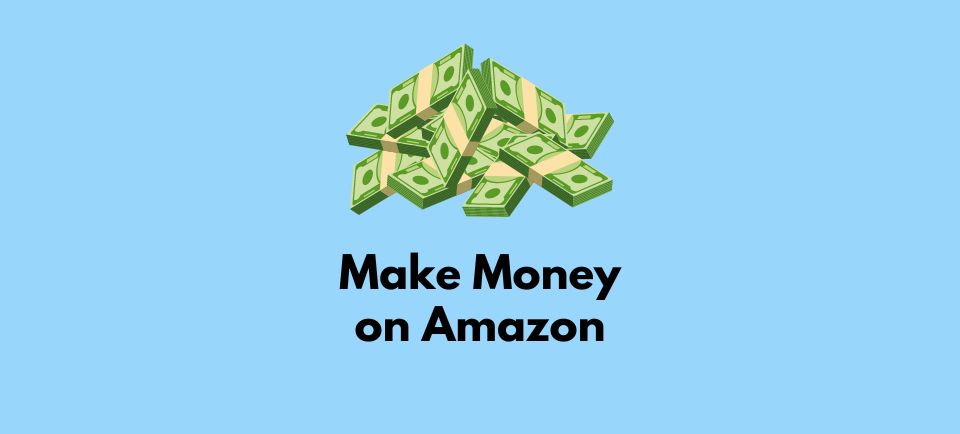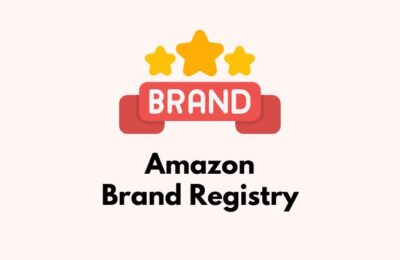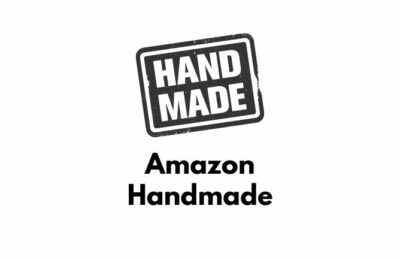Amazon is a massive marketplace offering numerous opportunities for entrepreneurs to make money. Whether you’re looking to sell products, create content, or offer services, Amazon has a platform that can suit your needs. In this beginner’s guide, we’ll explore five proven ways to make money on Amazon, detailing practical examples, pros and cons, budget requirements, and essential tips for success.

1. Selling Private Label Products
Overview: Private label selling involves sourcing generic products, branding them with your own label, and selling them on Amazon. This approach allows you to create a unique brand and stand out in the market.
Steps to Get Started:
Market Research:
- Identify Profitable Niches: Use tools like Jungle Scout or Helium 10 to find niches with high demand and low competition. Analyze market trends, customer reviews, and competitor products to understand what sells best.
- Validate Demand: Check for consistent sales volume and trends over time to ensure sustained demand.
Sourcing Products:
- Find Manufacturers: Use platforms like Alibaba, Global Sources, or even trade shows to find reliable manufacturers. Request samples to assess product quality.
- Negotiate Terms: Discuss pricing, minimum order quantities (MOQ), lead times, and payment terms with potential suppliers.
Branding:
- Develop Your Brand Identity: Create a compelling brand name, logo, and packaging design that resonates with your target audience.
- Intellectual Property: Consider trademarking your brand name and logo to protect your brand identity.
Listing Your Product:
- Product Listing: Create a detailed product listing on Amazon with high-quality images, bullet points, and an informative product description. Use optimized keywords to improve search visibility.
- Enhanced Content: Utilize Amazon’s Enhanced Brand Content (EBC) or A+ Content to provide rich product descriptions and images.
Launch and Promotion:
- Amazon Advertising: Use Amazon’s advertising tools like Amazon PPC (Pay-Per-Click) to drive traffic to your product listing.
- External Marketing: Promote your product through social media, influencer collaborations, email marketing, and other external channels to increase visibility and sales.
Practical Example: You identify a demand for eco-friendly kitchen products. After researching, you decide to source bamboo utensils. You find a manufacturer on Alibaba and negotiate terms. You brand the utensils as “EcoChef,” design eco-friendly packaging, and create an appealing product listing on Amazon. By utilizing optimized listings and targeted ads, you attract customers who value sustainable products.
Pros:
- Brand Control: Full control over your brand, product quality, and pricing.
- Higher Margins: Potential for higher profit margins.
- Brand Loyalty: Ability to build a loyal customer base.
Cons:
- Initial Investment: Requires significant upfront investment.
- Risk of Unsold Inventory: Potential for unsold stock.
- Competition: High competition in popular niches.
Budget Requirements:
- Product Sourcing: $1,000 – $5,000
- Branding and Packaging: $500 – $2,000
- Marketing and Advertising: $500 – $2,000
- Total Estimated Budget: $2,000 – $9,000
This is one of the most basic ways to make money on Amazon in 2024, but also one of the most satisfying in our opinion.
2. Retail Arbitrage
Overview: Retail arbitrage involves buying discounted products from retail stores and reselling them on Amazon at a higher price. This method leverages price discrepancies between different marketplaces to generate profit.
How to Get Started:
Product Research:
- Use the Amazon Seller App: Scan barcodes of products in stores to instantly see their current selling price on Amazon, sales rank, and estimated profit.
- Analyze Trends: Focus on trending categories like toys, electronics, and seasonal items which often have higher resale potential.
Sourcing Products:
- Visit Local Stores: Check clearance sections, discount stores, and big-box retailers like Walmart, Target, and Home Depot for deals.
- Online Marketplaces: Monitor websites like eBay, Overstock, and other online discount platforms for opportunities.
- Seasonal Sales: Capitalize on major sales events like Black Friday, Cyber Monday, and after-holiday sales for significant discounts.
Listing and Selling:
- Create Listings: List the sourced products on Amazon with competitive pricing. Ensure the listings are accurate and include clear images and detailed descriptions.
- Price Competitively: Regularly monitor competitor prices and adjust your listings to remain competitive without sacrificing profitability.
Fulfillment:
- Fulfillment by Amazon (FBA): Send your inventory to Amazon’s fulfillment centers where they handle storage, packaging, and shipping. This can save time and provide access to Amazon Prime customers.
- Self-Fulfillment: Store and ship products yourself, which can reduce costs but requires more hands-on management.
Practical Example: You find a popular board game on clearance for $10 and sell it on Amazon for $30, making a profit after fees.

Pros:
- Low Initial Investment: Start with a small budget.
- Quick Turnaround: Fast sales if priced competitively.
- Low Risk: Proven products with existing demand.
Cons:
- Time-Consuming: Regular store visits and research needed.
- Inventory Management: Challenges in tracking and restocking inventory.
- Variable Profit Margins: Fluctuating prices and competition.
Budget Requirements:
- Product Sourcing: $100 – $1,000
- Amazon Seller Fees: Approximately 15% of the sale price
- Fulfillment Costs: Varies based on FBA or self-fulfillment
- Total Estimated Budget: $100 – $1,500
3. Amazon Kindle Direct Publishing (KDP)
Overview: KDP allows authors to self-publish eBooks and paperbacks on Amazon, reaching a global audience and earning royalties. This platform empowers writers to bring their work to market quickly without the need for traditional publishing houses.
Steps to Get Started:
Write Your Book:
- Create Original Content: Write your book based on your knowledge, expertise, or passion. Alternatively, you can outsource writing to freelance writers.
- Edit and Proofread: Ensure the content is polished and free of errors. Consider hiring a professional editor for a thorough review.
Format Your Book:
- Kindle Formatting: Use tools like Kindle Create to format your manuscript for eBook publishing. Ensure compatibility with Kindle devices and apps.
- Print Formatting: For paperbacks, use Amazon’s guidelines to format your book correctly. Tools like Adobe InDesign or Vellum can help.
Design a Cover:
- Professional Design: Create an eye-catching cover that appeals to your target audience. Use design tools like Canva or hire a graphic designer through platforms like Fiverr or Upwork.
- Considerations: Ensure the cover meets Amazon’s specifications for both eBooks and paperbacks.
Publish on KDP:
- Upload Manuscript and Cover: Log in to your KDP account, upload your formatted manuscript and cover, and enter your book details (title, description, keywords, categories).
- Set Pricing and Royalties: Choose your pricing and royalty options. Amazon offers different royalty rates based on pricing and distribution options.
Promote Your Book:
- Amazon Marketing Tools: Use tools like Kindle Countdown Deals, Free Book Promotions, and Amazon Advertising to increase visibility.
- External Platforms: Promote your book through your blog, social media, email newsletters, and other marketing channels.
Practical Example: You write a comprehensive guide on digital marketing based on your expertise. After writing and formatting the book, you design an engaging cover and publish it on KDP. To drive sales, you promote the book through your blog, social media channels, and targeted Amazon ads. As the book gains traction, you earn royalties from each sale, creating a stream of passive income.
Pros:
- Low Upfront Costs: Minimal initial investment.
- Global Reach: Access to Amazon’s customer base.
- Passive Income: Earn royalties without ongoing effort.
Cons:
- High Competition: Difficult to stand out.
- Marketing Effort: Requires effective promotion.
- Quality Control: Ensuring high-quality content is essential.
Budget Requirements:
- Writing and Editing: $0 – $1,000 (depending on whether you write yourself or outsource, and if you hire an editor)
- Cover Design: $50 – $300 (cost varies based on the designer and complexity of the design)
- Marketing and Promotion: $100 – $500 (for Amazon ads, promotional campaigns, and external marketing efforts)
Total Estimated Budget: $150 – $1,800
By carefully crafting your book, ensuring high-quality content and design, and effectively promoting it, you can leverage KDP to reach a wide audience and generate a steady stream of royalties and make money on Amazon.

4. Amazon Merch by Amazon
Overview: Merch by Amazon is a print-on-demand service that allows you to create and sell custom apparel without managing inventory or handling fulfillment. Amazon takes care of production, shipping, and customer service, enabling you to focus on creating unique designs.
Steps to Get Started:
Apply for Merch by Amazon:
- Submit an Application: Visit the Merch by Amazon website and apply for an account. The approval process can take some time, so be patient.
- Approval: Once approved, you gain access to the Merch by Amazon dashboard where you can start uploading designs.
Create Designs:
- Design Unique Graphics: Use graphic design tools like Adobe Illustrator, Photoshop, or free alternatives like GIMP and Canva to create your designs.
- Market Research: Analyze trends and popular niches to create designs that appeal to your target audience.
Upload Designs:
- Choose Product Types: Select the types of apparel (e.g., t-shirts, hoodies, sweatshirts) and colors you want to offer.
- Upload Your Designs: Follow Amazon’s guidelines for image size and format to ensure your designs are displayed correctly on products.
Set Prices:
- Determine Selling Prices: Set competitive prices for your products while considering Amazon’s production costs and your desired profit margins.
Promote Your Products:
- Use Social Media: Promote your designs on platforms like Instagram, Facebook, Pinterest, and Twitter to reach a wider audience.
- External Marketing: Leverage your personal website, blog, and email newsletters to drive traffic to your Merch by Amazon store.
Practical Example: As a graphic designer, you create trendy t-shirt designs inspired by popular culture. After getting your account approved, you upload your designs to Merch by Amazon and select t-shirts as your primary product. You set competitive prices and promote your products through Instagram and your personal website. Sales start to roll in as people discover your unique designs.
Pros:
- No Inventory: No need for inventory management.
- Hands-Free Fulfillment: Amazon handles production and shipping.
- Scalability: Expand product line easily.
Cons:
- Limited Control: Amazon controls production.
- Approval Process: Not all applications are accepted.
- Profit Margins: Lower profit margins due to production costs.
Budget Requirements:
- Design Creation: $0 – $200
- Marketing and Promotion: $50 – $300
- Total Estimated Budget: $50 – $500
By creating compelling designs and effectively promoting them, Merch by Amazon offers a low-risk, hands-off way to enter the e-commerce space and build a brand around custom apparel.
5. Amazon Dropshipping
Overview: Dropshipping involves listing products for sale on Amazon without holding any inventory. When a customer places an order, you purchase the item from a third-party supplier who ships it directly to the customer. This business model eliminates the need for upfront inventory investment.
Steps to Get Started:
Set Up an Amazon Seller Account:
- Create an Account: Sign up for an Amazon Seller account to start listing products. Choose between an Individual or Professional selling plan based on your expected sales volume.
Find Reliable Suppliers:
- Use Platforms Like AliExpress or Oberlo: Research and select suppliers that offer quality products and reliable shipping. Read reviews and order samples if necessary to verify product quality and supplier reliability.
- Supplier Agreements: Establish clear agreements with your suppliers regarding shipping times, product quality, and return policies.
List Products on Amazon:
- Create Product Listings: Develop detailed and attractive product listings on Amazon. Include high-quality images, compelling descriptions, and optimized keywords to improve visibility.
- Price Competitively: Ensure your prices are competitive while allowing for a reasonable profit margin after accounting for Amazon fees and supplier costs.
Manage Orders:
- Purchase from Supplier: When a customer places an order on Amazon, you buy the product from the supplier and provide them with the customer’s shipping details.
- Direct Shipping: The supplier ships the product directly to the customer, reducing your involvement in the logistics process.
Customer Service:
- Handle Inquiries and Issues: Respond to customer questions and resolve any issues that arise, such as returns or complaints. Maintain a high level of customer service to ensure positive reviews and repeat business.
Practical Example: You list trendy phone accessories, such as cases and chargers, on Amazon. These products are sourced from suppliers on AliExpress. When a customer places an order, you purchase the item from the supplier, who then ships it directly to the customer. You earn the difference between the sale price on Amazon and the cost price from the supplier.
Pros:
- Low Start-Up Costs: No need for inventory investment.
- Minimal Risk: You only purchase products when you make a sale.
- Flexible Location: Can be managed from anywhere with an internet connection.
Cons:
- Lower Profit Margins: Due to higher supplier costs.
- Supplier Reliability: Risk of suppliers failing to meet shipping standards or product quality.
- Customer Service: You are responsible for handling customer issues despite not controlling the product.
Budget Requirements:
- Amazon Seller Fees: Approximately 15% of the sale price
- Supplier Costs: Variable, based on the product price
- Marketing and Promotion: $100 – $500
- Total Estimated Budget: $200 – $1,000
By leveraging the dropshipping model, you can start an Amazon business with minimal upfront investment and operational flexibility. However, success relies heavily on finding reliable suppliers and effectively managing customer service.
Conclusion
Amazon offers diverse opportunities for making money, from selling private label products and wholesale goods to leveraging print-on-demand services and affiliate marketing. Each method has its unique advantages, challenges, and budget requirements. By carefully considering your strengths, interests, and available resources, you can choose the most suitable approach to build a successful Amazon business. Thorough research, strategic planning, and consistent effort are key to maximizing your potential and achieving success on this dynamic platform.



